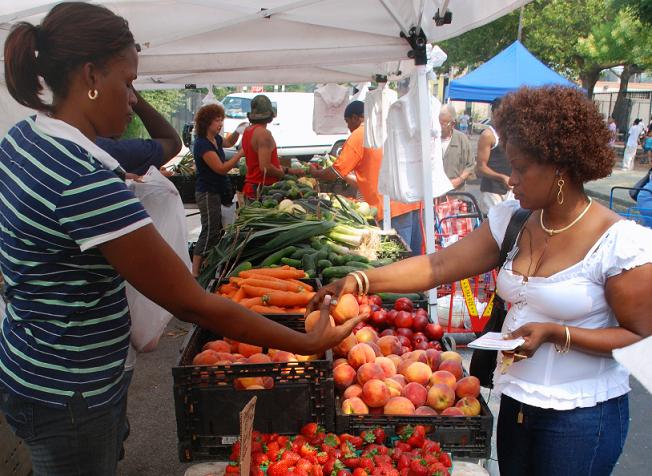A biweekly newsletter with public space news, resources, and opportunities.
A curated dispatch on all things public markets plus the latest announcements from the Market Cities Program.

In 2009, the Project for Public Spaces (PPS), with support from the Robert Wood Johnson Foundation and in partnership with Columbia University, undertook a study to examine what market characteristics successfully attract low-income shoppers. The study also explored the obstacles that may prevent low income individuals from shopping at a farmers market when one existed nearby, and how youth-oriented market programming affects healthy eating habits among kids and teens. Today, we are thrilled to share with you the results of this study, and to offer recommendations for everyone working to get more healthy food into their communities through farmers markets.
For the study, our team examined eight markets across the United States that served low- to middle-income communities with higher than average ethnic and minority compositions. Each market had unique attributes that identified them for selection. In addition, each market was a previous recipient of a PPS grant, funded by the Kellogg Foundation, which offered technical assistance between the years 2006-2008 in addition to funding.
Out of our analysis of market management data, tracked over several years and surveys of market shoppers and non-market shoppers, we were able to identify two key trends. First, we found that price is not a barrier. Among the survey sample, almost 60% of farmers market shoppers in low-income neighborhoods believed their market had better prices than the grocery store. Among those who did not shop at farmers markets, only 17% cited price as a barrier to shopping at their local farmers market. Second, we learned that information is key. Unlike a grocery store, markets typically lack permanent structures and are therefore more ephemeral by nature. Shoppers need better access to information about schedules and seasonal changes in order to become more regular market shoppers.
One of the most important lessons learned from the focus groups with youth interns at the markets was that the end goal was to produce excellent citizens, not necessarily urban farmers. While eating well, advocating for food justice, and increasing the youths’ knowledge of the local food production process were all taught, it was the emphasis on leadership, personal development, and responsibility that ultimately made the programs successful and left the strongest impact on the youth surveyed.
A summary of the recommendations included in the report:
It is our hope that the results of this study will help people to move the dial on creating healthier places through the creation of more effective, engaging farmers markets. Markets are wonderful public gathering spaces that put an emphasis on community health. They make it easier for people to make better dietary choices, while simultaneously bringing neighbors together to form the strong, supportive social networks that are critical to success in leading healthy lifestyles in the long term. And so, without further ado:
The rich text element allows you to create and format headings, paragraphs, blockquotes, images, and video all in one place instead of having to add and format them individually. Just double-click and easily create content.
The rich text element allows you to create and format headings, paragraphs, blockquotes, images, and video all in one place instead of having to add and format them individually. Just double-click and easily create content.
Body Text Body Link
The rich text element allows you to create and format headings, paragraphs, blockquotes, images, and video all in one place instead of having to add and format them individually. Just double-click and easily create content.
Here is some highlighted text from the article.




Headings, paragraphs, blockquotes, figures, images, and figure captions can all be styled after a class is added to the rich text element using the "When inside of" nested selector system.
Headings, paragraphs, blockquotes, figures, images, and figure captions can all be styled after a class is added to the rich text element using the "When inside of" nested selector system.
Headings, paragraphs, blockquotes, figures, images, and figure captions can all be styled after a class is added to the rich text element using the "When inside of" nested selector system.